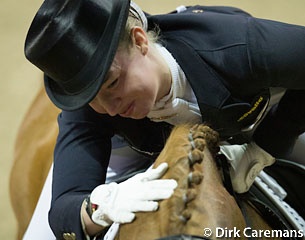
Researchers Ellis and Greening of The Horse Trust conducted an interesting study on whether scratching a horse is an effective reward while training horses. Riders and handlers are often observed to scratch their horse on the withers following successful completion of a desired behaviour. However the results of their study suggest that this does not necessarily translate across to a training scenario. Food appears to be a more effective reward than a scratch on the withers for horses.
Ellis and Greening presented this study "Positively reinforcing an operant task using tactile stimulation and food - a comparison in horses using clicker training" at the 2016 International Equitation Science Conference in Saumur, France, on 23 - 25 June 2016.
Positive reinforcement is a frequently employed method of horse training, commonly utilising food as a biologically significant stimulus to reward a desired behaviour. Whilst the replication of "allogrooming"behaviours with a human has been shown to lower equine heart rate, little quantitative evidence exists to describe the effectiveness of this type of tactile stimulation as a reinforcer.
How Has This Been Tested?
The researches compared the reinforcing properties of food against tactile stimulation on the withers, measuring latency to completion of an operant task. Fifteen horses (6 mares, 9 geldings; mean age 17.8±8 years) from mixed backgrounds (retired and rescue) were randomly assigned to one of three groups; group A received food as a primary reinforcer (3g of carrot), group B received a scratch on the withers for 5 seconds, and group C acted as a control (no reward).
During days 1 and 2 of the study (the conditioning phase) each horse was simultaneously exposed to a secondary reinforcer (a clicker) followed by a primary reinforcer dependant on their group (group C received nothing). On days 3, 4 and 5 (the experimental phase) horses were shaped to touch a target (a 94cm orange traffic cone). On each day, horses were given 30 consecutive opportunities (trials) to touch the cone following both a visual and auditory cue (pointing to the top of the cone and saying “touch”). If horses did not touch the cone within 10 seconds of the cue, the trial was recorded as a fail. Learning criteria was set at 80%.
Overall, there was a significant difference between groups for mean latency to touch the target. Tukey’s HSD post-hoc test highlighted a significant difference between the latency for group A (0.65 seconds) compared with group B (13.36 seconds) but with no differences between any other groups. Chi-squared test indicated a significant difference between groups for the total number of touches on the target. Group A was the closest to achieving learning criterion (75.6%), compared with group B (39.6%) and group C (26.4%).
On the fifth day, 3 horses (all from Group A) achieved learning criteria; two reached 96.67% and one 100%. Learning criteria for horses in groups B and C did not exceed 40%.
Conclusion
These results suggest that food is more effective at increasing the likelihood of a desired behaviour compared to wither scratching.
"This has implications for horse training both in-hand and under saddle as scratching may not reinforce a behaviour enough for it to be repeated at the required rate. Scratching of the withers may be reinforcing only for some individuals," Ellis and Greening concluded.
Source: ISES - Photo © Dirk Caremans
Related Links
ISES Suggest to Empower FEI Stewards to Control Tightness of Noseband
Is It Possible to Judge If a Horse is a Happy Athlete?
The Rise of Equitation Science Recognized at 2012 ISES Conference
ISES 2011 Bridging the Gap Between Science and Practice